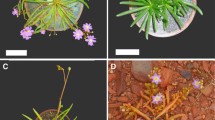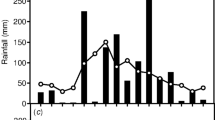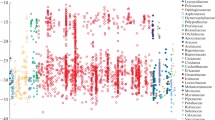Summary
Using determinations of overnigh changes in tissue titratable acidity and of tissue stable carbon isotope ratios, 10 species of terrestrial succulents were investigatedin situ in southeastern Jamaica for the presence of Crassulacean acid metabolism (CAM). Eight of the 10 species exhibited CAM (sensu lato), confirming past reports of CAM inClusia flava (Clusiaceae),Bryophyllum pinnatum (Crassulaceae),Euphorbia tirucalli (Euphorbiaceae), andPedilanthus tithymaloides (Euphorbiaceae) and extending the number of species with CAM in two genera previously known to contain CAM species (Agave sobolifera [Agavaceae] andSansevieria metalllica [Liliaceae]). Stems of bothE. tirucalli andP. tithymaloides exhibited CAM while the leaves of both species were intermediate with regard to photosynthetic pathway. The lack of CAM acid fluctuations inTalinum paniculatum (Portulacaceae) was surprising given past findings with all other species investigated in this genus. Shoots ofPilea microphylla (Urticaceae) were C3 yet were remarkable in their extremely high pH. Both species require further investigation. Nocturnal acid accumulations indicative of CAM were found inTripogandra multiflora andCallisia fragrans, both members of the Commelinaceae. This represents the first report of CAM (probably “CAM-cycling”) in this family.
Similar content being viewed by others
References
Adams CD (1972) Flowering plants of Jamaica. Univ West Indies, Mona, Jamaica
Bender MM (1971) Variations in the13C/12C ratios of plants in relation to the pathway of photosynthetic carbon dioxide fixation. Phytochem 10:1239–1244
Bharucha FR, Joshi GV (1958) Studies in Crassulacean metabolism inBryophyllum calycinum under tropical conditions. J Biol Sci (India) 1:5–12
Eder A, Stichler W, Ziegler H (1981) Mechanismen der CO2-Fixierung beiEuphorbia trigona Haw. und einigenPachypodium-Arten. Biochem Physiol Pflanzen 176:1–12
Ehleringer JR, Cooper TA (1988) Correlations between carbon isotope ratio and microhabitat in desert plants. Oecologia 76:562–566
Farquhar GD, Richards RA (1984) Isotopic composition of plant carbon correlates with water-use efficiency of wheat genotypes. Aust J Plant Physiol 11:539–552
Graf AB (1963) Exotica 3. Pictorial cyclopedia of exotic plants. Roehrs Co, NJ
Kluge M, Ting IP (1978) Crassulacean acid metabolism. Analysis of an ecological adaptation. Springer, Berlin Heidelberg New York
Lüttge U (1986) Nocturnal water storage in plants having Crassulacean acid metabolism. Planta 168:287–289
Lüttge U (1987) Carbon dioxide and water demand: Crassulacean acid metabolism (CAM), a versatile ecological adaptation exemplifying the need for integration in ecophysiological work. New Phytol 106:593–629
Martin CE, Lubbers AE, Teeri JA (1982) Variability in Crassulacean acid metabolism: a survey of North Carolina succulent species. Bot Gaz 143:491–497
Martin CE, Higley M, Wang W-Z (1988) Ecophysiological significance of CO2-recycling via Crassulacean acid metabolism inTalinum calycinum Engelm. (Portulacaceae). Plant Physiol 86:562–568
Medina E, Delgado M, Troughton JH, Medina JD (1977) Physiological ecology of CO2 fixation in Bromeliaceae. Flora 166:137–152
Milburn TR, Pearson DJ, Ndegwe NA (1968) Crassulacean acid metabolism under natural tropical conditions. New Phytol 67:883–897
Neales TF, Hew CS (1975) Two types of carbon fixation in tropical orchids. Planta 123:303–306
Nose A, Shiroma M, Miyazato K, Murayama S (1977) Studies on matter production in pineapple plants. I. Effects of light intensity in light period on the CO2 exchange and CO2 balance of pineapple plants. Jap J Crop Sci 46:580–587
Pfitsch WA, Smith AP (1988) Growth and photosynthesis ofAechmea magdalenae, a terrestrial CAM plant in a tropical moist forest, Panama. J Trop Ecol 4:199–207
Popp M, Kramer D, Lee H, Diaz M, Ziegler H, Lüttge U (1987) Crassulacean acid metabolism in tropical dicotyledonous trees of the genusClusia. Trees 1:238–247
Reddy AR, Das VSR (1978) The decarboxylating systems in fourteen taxa exhibiting CAM pathway. Z Pflanzenphysiol 86:141–146
Smith BN, Madhaven S (1982) Carbon isotope ratios in obligate and facultative CAM plants. In: Ting IP, Gibbs M (eds) Crassulacean acid metabolism. Am Soc Plant Physiol, Rockville MD, pp 231–243
Smith JAC, Lüttge U (1985) Day-night changes in leaf water relations associated with the rhythm of crassulacean acid metabolism inKalanchoë daigremontiana. Planta 163:272–282
Sokal RR, Rohlf FJ (1981) Biometry. 2nd edition WH Freeman, NY
Sutton BG, Osmond CB (1972) Dark fixation of CO2 by Crassulacean plants. Evidence for a single carboxylation step. Plant Physiol 50:360–365
Szarek SR (1979) The occurrence of Crassulacean acid metabolism: a supplementary list during 1976 to 1979. Photosynthetica 13:467–473
Szarek SR, Ting IP (1977) The occurrence of Crassulacean acid metabolism among plants. Photosynthetica 11:330–342
Teeri JA, Tonsor SJ, Turner M (1981) Leaf thickness and carbon isotope composition in the Crassulaceae. Oecologia 50:367–369
Tenhunen JD, Tenhunen LC, Ziegler H, Stichler W, Lange OL (1983) Variation in carbon isotope ratios ofEuphorbia species from different habitats of Teneriffe in the spring. Flora 173:363–370
Ting IP (1976) Crassulacean acid metabolism in natural ecosystems in relation to annual CO2 uptake patterns and water utilization. In: Burris RH, Black CC (eds) CO2 metabolism and plant productivity. Univ Park Press, Baltimore, MD, pp 251–268
Ting IP, Bates L, Sternberg LO, DeNiro MJ (1985) Physiological and isotopic aspects of photosynthesis inPeperomia. Plant Physiol 78:246–249
Virzo De Santo A, Fioretto A, Alfani A (1982) The adaptive significance of growth form, leaf morphology, and CAM in the genusSansevieria. Delpinoa NS 24:307–323
Virzo De Santo A, Alfani A, Russo G, Fioretto A (1983) Relationship between CAM and succulence in some species of Vitaceae and Piperaceae. Bot Gaz 144:342–346
Webster GL, Brown WV, Smith BN (1975) Systematics of photosynthetic carbon fixation pathways in Euphorbia. Taxon 24:27–33
Winter K (1985) Crassulacean acid metabolism. In: Barber J, Baker NR (eds) Photosynthetic mechanisms and the environment. Elsevier, Amsterdam, pp 329–387
Author information
Authors and Affiliations
Rights and permissions
About this article
Cite this article
Martin, C.E., Loeschen, V.S. & Coke, L.B. Crassulacean acid metabolism in selected terrestrial succulents in southeastern Jamaica, including two species in the Commelinaceae. Oecologia 84, 99–102 (1990). https://doi.org/10.1007/BF00665601
Received:
Accepted:
Issue Date:
DOI: https://doi.org/10.1007/BF00665601




